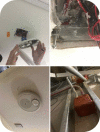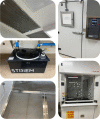Lessons Learned from the Design, Construction, and Commissioning of a Retrofitted Arthropod Containment Level 3 Insectary
- PMID: 37188338
- PMCID: PMC10324019
- DOI: 10.4269/ajtmh.22-0790
Lessons Learned from the Design, Construction, and Commissioning of a Retrofitted Arthropod Containment Level 3 Insectary
Abstract
Arthropods are vectors for many pathogens that significantly harm human and animal health globally, and research into vector-borne diseases is of critical public health importance. Arthropods present unique risks for containment, and therefore insectary facilities are essential to the safe handling of arthropod-borne hazards. In 2018, the School of Life Sciences at Arizona State University (ASU) began the process to build a level 3 arthropod containment (ACL-3) facility. Even with the COVID-19 pandemic, it took more than 4 years for the insectary to be granted a Certificate of Occupancy. At the request of the ASU Environmental Health and Safety team, Gryphon Scientific, an independent team with biosafety and biological research expertise, studied the project lifecycle through the design, construction, and commissioning of the ACL-3 facility with the goal of identifying lessons learned from the delayed timeline. These lessons learned convey insight into best practices for assessing potential facility sites, anticipating challenges with retrofitted construction, preparing for commissioning, equipping the project team with necessary expertise and expectations, and supplementing the gaps in available containment guidance. Several unique mitigations designed by the ASU team to address research risks not specifically addressed in the American Committee of Medical Entomology Arthropod Containment Guidelines are also described. Completion of the ACL-3 insectary at ASU was delayed, but the team thoroughly assessed potential risks and enabled appropriate practices for the safe handling of arthropod vectors. These efforts will enhance future ACL-3 construction by helping to avoid similar setbacks and streamlining progress from concept to operation.
Figures



References
-
- Abdellahoum Z. et al., 2022. Identification of Algerian field-caught mosquito vectors by MALDI-TOF MS. Vet Parasitol Reg Stud Rep 31: 100735. - PubMed
-
- National Institutes of Health , 2016. Design Requirements Manual. Bethesda, MD: NIH.
-
- National Institutes of Health , 2012. NIH Laboratory Sealant Requirements in News to Use: Design Requirements Manual (Vol. 1). Bethesda, MD: NIH.
-
- Animal and Plant Health Inspection Service , 2002. Containment Guidelines for Nonindigenous, Phytophagous Arthropods and Their Parasitoids and Predators. Washington, DC: USDA.
-
- Department of Health and Human Services , 2020. Biosafety in Microbiological and Biomedical Laboratories (BMBL). Washington, DC: U.S. Department of Health.
Publication types
MeSH terms
LinkOut - more resources
Full Text Sources
Medical

